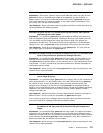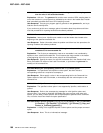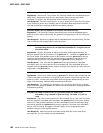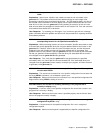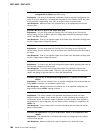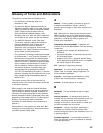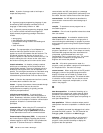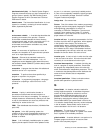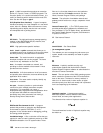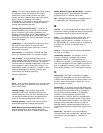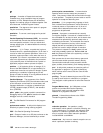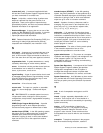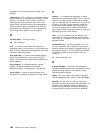
Glossary of Terms and Abbreviations
This glossary includes terms and definitions from:
The
Dictionary of Computing
, New York:
McGraw-Hill, 1994.
The
American National Standard Dictionary for
Information Systems
, ANSI X3.172-1990, copyright
1990 by the American National Standards Institute
(ANSI). Copies can be purchased from the
American National Standards Institute, 1430
Broadway, New York, New York 10018. Definitions
are identified by the symbol (A) after the definition.
The
ANSI/EIA Standard - 440A: Fiber Optic
Terminology
, copyright 1989 by the Electronics
Industries Association (EIA). Copies can be
purchased from the Electronic Industries
Association, 2001 Pennsylvania Avenue N.W.,
Washington, D.C. 20006. Definitions are identified
by the symbol (E) after the definition.
The
Information Technology Vocabulary
developed
by Subcommittee 1, Joint Technical Committee 1, of
the International Organization for Standardization
and the International Electrotechnical Commission
(ISO/IEC JTC1/SC1). Definitions of published parts
of this vocabulary are identified by the symbol (I)
after the definition; definitions taken from draft
international standards, committee drafts, and
working papers being developed by ISO/IEC
JTC1/SC1 are identified by the symbol (T) after the
definition, indicating that final agreement has not yet
been reached among the participating National
Bodies of SC1.
This section contains some of the terms that are
commonly used in the Parallel Environment books and
in this book in particular.
IBM is grateful to the American National Standards
Institute (ANSI) for permission to reprint its definitions
from the American National Standard
Vocabulary for
Information Processing
(Copyright 1970 by American
National Standards Institute, Incorporated), which was
prepared by Subcommittee X3K5 on Terminology and
Glossary of the American National Standards
Committee X3. ANSI definitions are preceded by an
asterisk (*).
Other definitions in this glossary are taken from
IBM
Vocabulary for Data Processing, Telecommunications,
and Office Systems
(GC20-1699).
A
address. A value, possibly a character or group of
characters that identifies a register, a device, a
particular part of storage, or some other data source or
destination.
AIX. Abbreviation for Advanced Interactive Executive,
IBM's licensed version of the UNIX operating system.
AIX is particularly suited to support technical computing
applications, including high function graphics and
floating point computations.
AIXwindows Environment/6000. A graphical user
interface (GUI) for the IBM RS/6000. It has the following
components:
A graphical user interface and toolkit based on
OSF/Motif
Enhanced X-Windows, an enhanced version of the
MIT X Window System
Graphics Library (GL), a graphical interface library
for the applications programmer which is compatible
with Silicon Graphics' GL interface.
API. Application Programming Interface.
application. The use to which a data processing
system is put; for example, topayroll application, an
airline reservation application.
argument. A parameter passed between a calling
program and a called program or subprogram.
attribute. A named property of an entity.
B
bandwidth. The total available bit rate of a digital
channel.
blocking operation. An operation which does not
complete until the operation either succeeds or fails. For
example, a blocking receive will not return until a
message is received or until the channel is closed and
no further messages can be received.
breakpoint. A place in a program, specified by a
command or a condition, where the system halts
execution and gives control to the workstation user or to
a specified program.
broadcast operation. A communication operation in
which one processor sends (or broadcasts) a message
to all other processors.
Copyright IBM Corp. 1996, 1998 187



